Applications of MR contrast Agents
> research > Applications of MR contrast Agents
Magnetic Resonance Imaging (MRI)provides high-resolution three-dimensional images of the internal part of the body depending on the signal intensity difference in the in vivo distribution of the water molecules. MRI has been one of the most powerful techniques for the noninvasive diagnostic technique of the human anatomy, physiology and pathophysiology on the basis of superior spatial resolution and contrast. At present, MRI contrast agents (CAs) are applied to enhance the contrast effect, compensating the limitation on low sensitivity of MRI
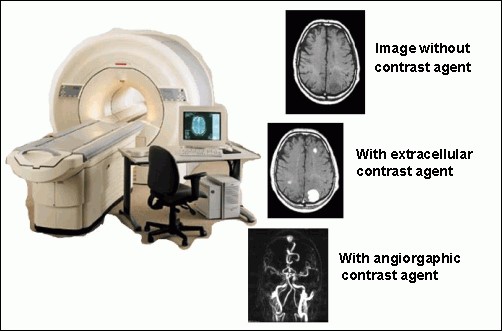
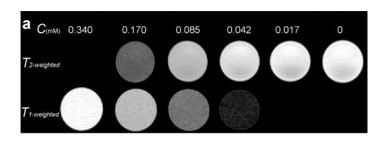
gadolinium complex is used the most as a MRI CAs due to its strongest paramagnetic property. It shows effectively strong signal enhancement in MRI. These contrast agents catalytically shorten the relaxation time of the nearby water molecules to enhance the contrast with the background tissues in the MR images. The enhanced usage of MRI as the diagnostic imaging modality prompts the development of efficient MRI CAs. We have synthesized new functional contrast agents and characterize about their chemical, biological, physical properties and potential medicinal efficiency as a contrast agent. For several decades, the commercial MRI CA has been developed as a extracellular fluid (ECF) agent which rapidly excretes to extracellular region without any special function. Recently, the MRI CA researches have been done on, 'Targeting agents', 'Manganese agents', 'Chemical exchange saturation transfer (CEST)', 'Paramagnetic CEST (para CEST)', 'Lanthanide complex MRI contrast agent' and so on to have various function.
1. Targeting agent
the targeting CA can be designed as organ-specific, blood-pool, cancer-specific and inflammation-specific CA etc. the commercial organ-specific agent having lipophilic moiety helps liver enhancement. Also blood-pool agent is strongly bound to endogenous protein, serum albumin, to have a long blood vessel residual time. If a CA have cancer marker, it would show cancer specific signal enhancement. It is called as a diagnostic agent.br/>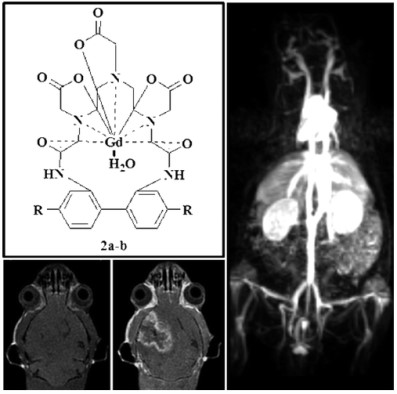
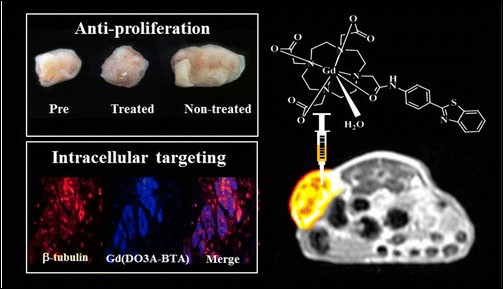
2. Manganese agent
Recently, new manganese complex have been developed as a alternative MRI contrast agents. manganese complex has relatively low in vivo toxicity than gadolinium complex. Also, it has similar relaxivity with gadolinium complex.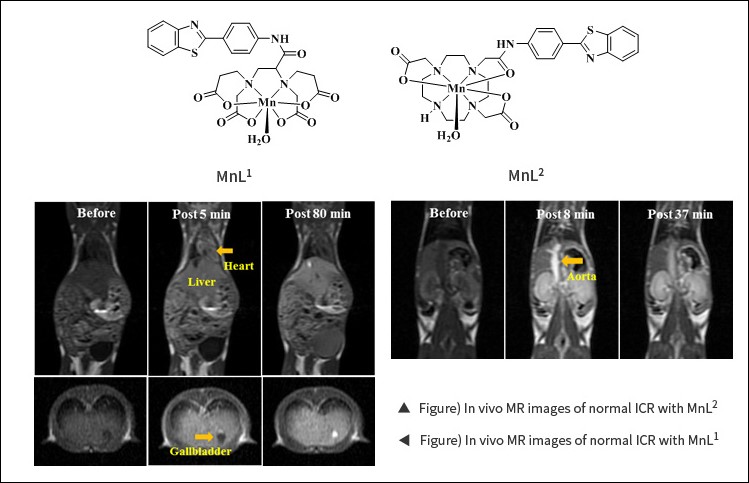
3. CEST & Para CEST
the CEST and ParaCEST are MRI scanning method by using chemical exchange of exchangeable proton with in vivo bulk water proton. the chemical exchange of saturated in vivo proton result in fractional water signal reducing. this water signal reducing could be differed according to pH or temperature. Some of the molecules that have been proven to work as potential agents are small diamagnetic molecules, complexes of paramagnetic ions, endogenous macromolecules, dimers and liposomes. CEST uses diamagentic substance which has a short chemical shift range, 0~12 ppm. However, ParaCEST uses the paramagentic complex, like Eu, Tb complex to obtain the chemical exchange with water proton and it has the relatively long chemical shift range, ~100 ppm. CEST or ParaCEST effect can be differed according to chemical structure of such a agents.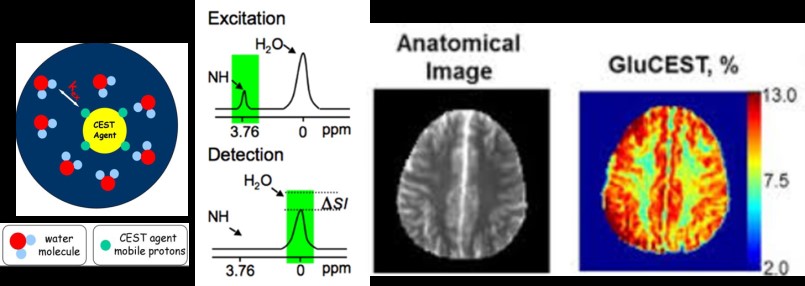

мһҗкё°кіөлӘ…мҳҒмғҒмқҖ 비침мҠөм Ғ 진лӢЁ мһҘ비лЎң CT, PET, SPECTмҷҖ 비көҗмӢң лҶ’мқҖ н•ҙмғҒлҸ„мқҳ 3м°Ёмӣҗ н•ҙл¶Җн•ҷм Ғ мҳҒмғҒмқ„ м ңкіөн•©лӢҲлӢӨ. мқёмІҙ лӮҙ л¬ј 분мһҗлҘј мқҙмҡ©н•ҳм—¬ мҳҒмғҒмқ„ л§Ңл“Өм–ҙлӮҙлҠ” мһҗкё°кіөлӘ…мҳҒмғҒм—җм„ңлҠ” л¬ј 분мһҗк°Җ мЎҙмһ¬н•ҳлҠ” нҷҳкІҪм—җ л”°лқј м„ңлЎң лӢӨлҘё мӢ нҳё к°•лҸ„лҘј ліҙмқҙл©°, мЎ°м§Ғ к°„мқҳ мӢ нҳё м°Ёмқҙ, мҰү мӢ нҳё лҢҖмЎ°лҸ„к°Җ нҒҙмҲҳлЎқ мЎ°м§Ғмқҳ н•ҙл¶Җн•ҷм Ғ мҳҒмғҒмқҳ м§Ҳмқҙ н–ҘмғҒ лҗҳлҠ” нҡЁкіјк°Җ мһҲмҠөлӢҲлӢӨ. лӢӨлҘё мҳҒмғҒ 진лӢЁ мһҘ비м—җ 비н•ҳм—¬ лӮ®мқҖ мӢ нҳё к°җлҸ„лҘј к°Җ진 мһҗкё°кіөлӘ…мҳҒмғҒмқҖ мЎ°мҳҒмҰқк°•м ң(мқјлӘ… мЎ°мҳҒм ң)лҘј мӮ¬мҡ©н•ҳм—¬ лҚ” нҒ° мҳҒмғҒ лҢҖмЎ°лҸ„лҘј м–»кі мһҲмңјл©°, мқҙл•Ң лҶ’мқҖ мғҒмһҗм„ұ м„ұм§Ҳмқ„ нҶөн•ҙ нҡЁкіјм ҒмңјлЎң мҳҒмғҒ лҢҖмЎ°лҸ„ мҰқк°•мқ„ лӮҳнғҖлӮј мҲҳ мһҲлҠ” к°ҖлҸҢлҰ¬лҠ„ м°©л¬јмқ„ ліҙнҺём ҒмңјлЎң мӮ¬мҡ©н•ҳкі мһҲмҠөлӢҲлӢӨ.
мқҙлҹ¬н•ң мһҗкё°кіөлӘ…мҳҒмғҒ мЎ°мҳҒмҰқк°•м ңлҠ” мҙүл§Өм ңлЎң мһ‘мҡ©н•ҳм—¬ мқёмІҙ лӮҙ л¬ј 분мһҗмқҳ м—җл„Ҳм§Җ мҷ„нҷ”лҘј л№ лҘҙкІҢ н•ҳлҠ” м—ӯн• мқ„ н•ҳл©° мЎ°мҳҒмҰқк°•м ң нҲ¬м—¬ м „м—җ 비н•ҳм—¬ л°қкұ°лӮҳ м–ҙл‘җмҡҙ мҳҒмғҒмқ„ м–»кІҢ н•ҳм—¬ мЎ°м§Ғ л°Ҹ лі‘ліҖмқ„ лҚ”мҡұ мүҪкІҢ кө¬л¶„н• мҲҳ мһҲлҸ„лЎқ н•©лӢҲлӢӨ.


нҳ„мһ¬ к№Ңм§Җ к°ңл°ңлҗң мғҒмҡ© мЎ°мҳҒмҰқк°•м ңл“ӨмқҖ мЈјмӮ¬ нӣ„ л№ лҘҙкІҢ м„ёнҸ¬ мҷём•ЎмңјлЎң л°°м¶ңлҗҳлҠ” ECF мЎ°мҳҒм ңл“Өмқҙ мЈјлҘј мқҙлЈЁкі мһҲмңјл©° мқҙл“Ө ECF мЎ°мҳҒм ңк°Җ к°–м§Җ лӘ»н•ң лӢӨм–‘н•ң кё°лҠҘ(мһҘкё° нҠ№мқҙм Ғ мЎ°мҳҒмҰқк°• нҡЁлҠҘ л“ұ)мқ„ к°Җм§ҖлҠ” мЎ°мҳҒм ңлҘј к°ңл°ңн•ҳкё° мң„н•ҳм—¬ м—¬лҹ¬ л°©н–ҘмңјлЎңмқҳ м—°кө¬к°Җ 진н–ү мӨ‘мһ…лӢҲлӢӨ.
мөңк·ј мһҗкё°кіөлӘ…мҳҒмғҒ мЎ°мҳҒм ң м—°кө¬м—җм„ңлҠ” лӢӨм–‘н•ң нҠ№м„ұмқ„ лӮҳнғҖлӮҙлҠ” 'Targeting agents', 'Manganese agents', 'Chemical exchange saturation transfer (CEST)', 'Paramagnetic CEST (para CEST)', 'Lanthanide complex MRI contrast agent' л“ұмқҳ 분야м—җм„ң к°ңл°ңмқҙ мқҙлЈЁм–ҙм§Җкі мһҲмҠөлӢҲлӢӨ.
1. Targeting agent
Organ-specific, Blood-pool, Cancer-specific, Inflammation-specific л“ұ лӢӨм–‘н•ң нҳ•нғңмҷҖ кё°лҠҘмқ„ к°Җм§ҖлҠ” н‘ңм Ғм„ұ мЎ°мҳҒмҰқк°•м ңк°Җ к°ңл°ңлҗҳм–ҙ мҷ”мңјл©°, мғҒмҡ© Organ-specific мЎ°мҳҒмҰқк°•м ңлЎңлҠ” м№ңм§Җм§Ҳм„ұмқҳ кё°лҠҘкё°лҘј к°Җм§ҖлҠ” к°„ мЎ°мҳҒм ңк°Җ мһҲмҠөлӢҲлӢӨ. лҳҗн•ң м •л§Ҙ мЈјмӮ¬ нӣ„м—җ нҳҲкҙҖм—җ 비көҗм Ғ мҳӨлһң мӢңк°„ лЁёл¬јл©° ліөл¶Җ лҢҖлҸҷл§Ҙ л°Ҹ кё°нғҖ нҳҲкҙҖмқ„ к°•н•ҳкІҢ мЎ°мҳҒмҰқк°•мӢңнӮӨлҠ” Blood-pool мЎ°мҳҒмҰқк°•м ңлҠ” нҳҲкҙҖ лӮҙ лӢЁл°ұм§Ҳмқё Serum albuminкіј к°•н•ҳкІҢ кІ°н•©н•ҳм—¬ нҳҲкҙҖ мЎ°мҳҒ нҡЁкіјлҘј лӮҳнғҖлӮҙлҠ” кІғмңјлЎң м•Ңл Өм ё мһҲмҠөлӢҲлӢӨ. лҳҗн•ң мЎ°мҳҒмҰқк°•м ңк°Җ м•”м„ёнҸ¬ л°Ҹ мў…м–‘м—җ н‘ңм Ғм„ұмқ„ к°Җм§ҖлҠ” markerлҘј кё°лҠҘкё°лЎң к°Җм§Җкі мһҲлӢӨл©ҙ м•” н‘ңм Ғм„ұ мЎ°мҳҒ нҡЁкіјлҘј к°Җм§ҖлҠ” 진лӢЁмҡ© MRI мЎ°мҳҒмҰқк°•м ңлЎңм„ң м—ӯн• мқ„ н•ҳкІҢ лҗ©лӢҲлӢӨ.

2. Manganese agent
мөңк·ј мғҲлЎңмҡҙ л§қк°„ м°©л¬јл“Өмқҙ к°ҖлҸҢлҰ¬лҠ„мқ„ лҢҖмІҙн• мһҗкё°кіөлӘ…мҳҒмғҒ мЎ°мҳҒмҰқк°•м ңлЎң к°ңл°ңмқҙ лҗҳкі мһҲмҠөлӢҲлӢӨ. к°ҖлҸҢлҰ¬лҠ„м—җ 비н•ҳм—¬ лӮ®мқҖ мғқмІҙ лҸ…м„ұмқ„ к°Җ진лӢӨлҠ” мһҘм җмқҙ мһҲмңјл©° мЎ°мҳҒмҰқк°•м ңмқҳ нҡЁмңЁмқ„ лӮҳнғҖлӮҙлҠ” relaxivity лҳҗн•ң л§қк°„ м°©л¬јмқҳ нҷ”н•ҷм Ғ кө¬мЎ°м—җ л”°лқј к°ҖлҸҢлҰ¬лҠ„ м°©л¬јмқҳ relaxivityмҷҖ мң мӮ¬н•ң к°’мқ„ лӮҳнғҖлӮҙм–ҙ нҡЁкіјм Ғ мҳҒмғҒ лҢҖмЎ°лҸ„лҘј м–»лҠ” мһҘм җмқҙ мһҲм–ҙ, мЎ°мҳҒмҰқк°•м ң к°ңл°ң 분야м—җм„ңлҠ” мқҙм—җ лҢҖн•ң м—°кө¬к°Җ нҷңл°ңнһҲ 진н–ү мӨ‘мһ…лӢҲлӢӨ.
3. CEST & ParaCEST
CESTмҷҖ ParaCESTлҠ” көҗнҷҳ к°ҖлҠҘн•ң м–‘м„ұмһҗмҷҖ мғқмІҙ лӮҙ лІҢнҒ¬ л¬јмқҳ м–‘м„ұмһҗмқҳ нҷ”н•ҷм Ғ көҗнҷҳмқ„ мқҙмҡ©н•ң MRI мҠӨмәҗлӢқ л°©лІ•мһ…лӢҲлӢӨ. нҸ¬нҷ”лҗң мғқмІҙ лӮҙ м–‘м„ұмһҗмқҳ нҷ”н•ҷм Ғ көҗнҷҳмқҖ л¬ј 분мһҗмқҳ мӢ нҳё к°җмҶҢлҘј лӮҳнғҖлӮҙкІҢ н•©лӢҲлӢӨ. л¬ј мӢ нҳёмқҳ к°җмҶҢлҠ” pH лҳҗлҠ” мҳЁлҸ„м—җ л”°лқј лӢ¬лқјм§Ҳ мҲҳ мһҲмҠөлӢҲлӢӨ. мқҙлҹ¬н•ң CEST, ParaCEST мЎ°мҳҒмҰқк°•м ңлЎңм„ңлҠ” diamagnetic м Җ분мһҗ м°©л¬ј, paramagentic м Җ분мһҗ м°©л¬ј, лӮҳл…ё м•Ҫл¬ј м „лӢ¬ мҠӨмӢңн…ң, dimer л°Ҹ лҰ¬нҸ¬мўҖ л“ұмқҳ нҳ•нғңлЎң л””мһҗмқёлҗ мҲҳ мһҲмҠөлӢҲлӢӨ. CESTлҠ” chemical shift лІ”мң„к°Җ 0 ~ 12 ppm мқё diamagnetic л¬јм§Ҳмқ„ мӮ¬мҡ©н•©лӢҲлӢӨ. мқҙмҷҖлҠ” лӢ¬лҰ¬, ParaCESTм—җм„ңлҠ” л¬ј м–‘м„ұмһҗмҷҖмқҳ нҷ”н•ҷм Ғ көҗнҷҳмқ„ м–»кё° мң„н•ҙ Eu, Tb ліөн•©мІҙмҷҖ к°ҷмқҖ paramagentic м°©л¬јмқ„ мӮ¬мҡ©н•ҳл©°, chemical shift лІ”мң„к°Җ ~ 100 ppm мқё мғҒлҢҖм ҒмңјлЎң кёҙ нҷ”н•ҷм Ғ мқҙлҸҷ лІ”мң„лҘј к°Җм§Җкі мһҲмҠөлӢҲлӢӨ. CEST лҳҗлҠ” ParaCEST нҡЁкіјмҷҖ к°ҖлҠҘмқҖ мЎ°мҳҒмҰқк°•м ңмқҳ нҷ”н•ҷм Ғ кө¬мЎ°м—җ л”°лқј лӢӨлҘј мҲҳ мһҲмҠөлӢҲлӢӨ.

601, 515-3, Hakjeong-dong, Buk-gu, Daegu 702-911, Republic of KOREA | Tel : +82-53-950-4128, 4129 | e-mail : ychang@knu.ac.kr
Copyright(c) 2016 Kyungpook National University School of Medicine BMR lab. All rights reserved.


